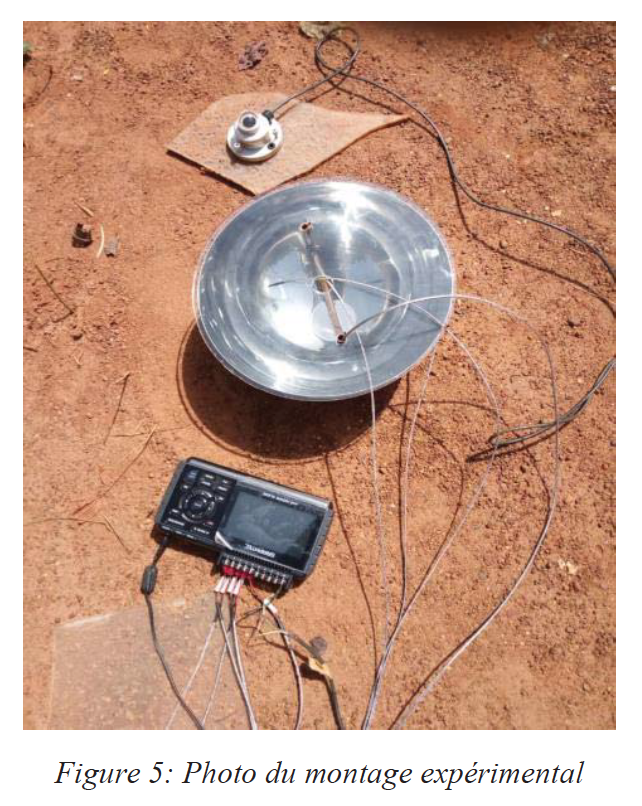Expérimentation et analyse thermique d’un concentrateur hémisphérique stationnaire sous les conditions climatiques à Ouagadougou, Burkina Faso
- Post by: SOAPHYS-KZ
- 31 mars 2021
- Comments off


Section de la parution: Informations de publication
J. P. Soaphys, Vol 2, N°1 (2020) C20A04; 31 Mars 2021
Pages : C20A04-1 à C20A04-5
Information sur les auteurs
Les concentrateurs solaires constituent une technologie adaptée à l’exploitation de l’énergie solaire à haute température mais aussi à des températures intermédiaires. Cette technologie est utilisée dans le séchage, le chauffage d’eau sanitaire ou dans la production d’électricité. Cependant elle utilise un système de traque solaire qui est trop complexe et couteuse pour les pays moins équipés et ayant un fort potentiel solaire. Dans cette étude, on s’intéresse à l’expérimentation et à l’analyse thermique d’un concentrateur hémisphérique stationnaire. La résolution numérique des équations de la caustique d’un concentrateur sphérique a permis de déterminer les dimensions et la position du receveur, nécessaires à la conception du modèle physique et au montage du dispositif expérimental. Les résultats de la simulation numérique à 3D avec le logiciel Comsol5.3a ont permis de mettre en évidence le tracé des rayons et le profil du flux concentré sur le receveur. Les résultats obtenus expérimentalement montrent que le receveur et l’air à l’intérieur ont atteint respectivement une température maximale de 224 °C et 97,6 °C. Le dispositif de concentration solaire étudié est donc techniquement favorable à des applications thermiques nécessitant des températures intermédiaires.
Mots-Clés: Concentrateur hémisphérique, stationnaire, énergie solaire, température intermédiaire
A B S T R A C T
This technology is used in drying, domestic water heating or in the production of electricity. However, it uses a solar tracking system that is too complex and expensive for countries with less equipment and high solar potential. In this study, we are interested in the experimentation and thermal analysis of a stationary hemispheric concentrator. The numerical resolution of the caustic equations of a spherical concentrator allowed to determine the dimensions and the position of the receiver, necessary for the design of the physical model and the assembly of the experimental device. The results of the 3D numerical simulation with the Comsol5.3a software allowed to highlight the ray tracing and the profile of the flow concentrated on the receiver. The results obtained experimentally show that the receiver and the air inside reached a maximum temperature of 224°C and 97.6°C respectively. The solar concentration device studied is therefore technically favorable for thermal applications requiring intermediate temperatures.
Keywords : Hemispherical concentrator, stationary, solar energy, intermediate température
| [1] T. Arvind and T. Shyam, « Handbook of Solar Energy/ Theory, Analysis and Applications, » in Energy Systems in Electrical Engineering, Media Singapore, 2016, p. 774. | ||||
| [2] B. M. Pakouzou, M. S. T. Ky, S. T. Gbembongo, and G. P. Ouedraogo, « Thermal Performance of a Receiver Located in the Caustic Area of a Cylindro-Parabolic Solar Concentrator, » Phys. Sci.Int. J., vol. 16, no. 3, pp. 1-14, 2017. https://doi.org/10.9734/PSIJ/2017/37156 |
||||
| [3] D. Guerraiche, B. Ammar, and H. Ben Moussa, « Facteurs optiques et géométriques caractérisant un concentrateur cylindro-parabolique, » Rev. Des Energies Renouvelables, vol. 14, no. 02, pp. 229 -238, 2011. | ||||
| [4] V. S. Reddy, S. C. Kaushik, and S. K. Tyagi, « Exergetic analysis and performance evaluation of parabolic trough concentrating solar thermal power plant ( PTCSTPP ), » Energy, vol. 39, no. 1, pp. 258-273, 2012. https://doi.org/10.1016/j.energy.2012.01.023 |
||||
| [5] Y. Boukhchana, A. Fellah, and A. Ben Brahim, « Etudes théorique et expérimentale des performances d ‘ un capteur solaire cylindroparabolique, » in Congrès International sur les Energies Renouvelables et l’Environnement, 2010, pp. 1-9. | ||||
| [6] S. M. T. Ky, M. Pakouzou, B. Dianda, M. Ousmane, S. Kam, and D. J. Bathiebo, « Air Heating In A Steady Hemispherical Concentrating System For Various Applications, » Int. J. Curr.Res., vol. 10, no. 02, pp. 65449-65454, 2018. | ||||
| [7] A. Arconada and F. Papini, « Bilan thermique des convertisseurs de l’énergie solaire : rôle de la sélectivité et de la concentration, » Rev. Phys.Appliquée, vol. 15, no. 2, pp. 163-167, 2080. https://doi.org/10.1051/rphysap:01980001502016300 |
||||
| [8] S. Cohen and G. Grossman, « Development of a solar collector with a stationary spherical reflector / tracking absorber for industrial process heat, » Sol. ENERGY, 2015. https://doi.org/10.1016/j.solener.2015.05.036 |
||||
| [9] T. S. M. KY, « Analyse Des Images Optiques Des Concentrateurs Solaires. Application Pour La Conception De Fours A Pain, » Ouaga I Pr Joseph KI-ZEBO, Ouagadou, Burkina-Faso, 2016. | ||||
| [10] W. G. Steward and F. Kreith, « Stationary concentrating reflector cum tracking absorber solar energy collector : optical design characteristics, » Appl. Opt., vol. 14, no. 7, pp. 1509-1512, 2075. https://doi.org/10.1364/AO.14.001509 |
||||
| [11] C. Villasante et al., « Low-Cost Solar Electricity Using Stationary Solar Fields; Technology Potential and Practical, » energies, vol. 13, no.1816, pp. 1-14, 2020. https://doi.org/10.3390/en13071816 |
||||
| [12] M. KHALED, « Conception et réalisation d’un concentrateur sphérique, » Universite Mentouri Constantine, CONSTANTINE, ALGERIE, 2008. | ||||
| [13] S. M. T. Ky, B. Dianda, E. Ouedraogo, S. Ouedraogo, and D. J. Bathiebo, « Novel Natural Convection Process : Indirect Solar Dryer Built with Spherical Novel Application to Tomato Drying ., » Elixir Therm. Eng., vol. 122, pp. 51615- 51620, 2018. | ||||
| [14] T. S. M. Ky, B. Dianda, M. Ousmane, M. Pakouzou, and D. J. Bathiebo, « Optical and Thermal Performance Analysis of a Steady Spherical Collector with a Crescent- shaped Rotating Absorber, » vol. 6495, no. 4, pp. 234-245, 2017. https://doi.org/10.22161/ijaers.4.4.37 |
||||


